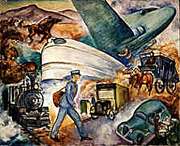
PA0389
 |
While the art world may
have been moving away from the more scientific influences
that
had captured his imagination, Haydon's other interests
in social development found an outlet in the American Scene
subjects at the heart of Midwestern regionalist art. Three
paintings from the late 1930s display subjects and styles
that would have been well received within the WPA spirit,
as well as within the spirit of the progressive educational
movement and their optimistic views of modern life. In
an
untitled and undated work, Haydon depicts the history of
the U.S. Postal Service
(untitled, c. 1938, oil on canvas, 21 x 25 1/2", PA0389).
Organized into a very successfully composed montage, he
has every phase from the pony express, stage coach and
steam
locomotive means of mail transportation to the more contemporary
methods of airplane, diesel train and truck. Also included
are images of both rural free delivery to mail boxes in
the country and home delivery in the cities exemplified
by the
striding letter carrier. Modern life with its speed, convenience
and benefits for more individuals is another theme at the
heart of this tribute.
Another untitled work is quite unusual and much less clear as to its meaning,
and Haydon left no known explanation of it. (untitled,
c. 1938, oil on canvas, 12 1/4 x 32", PA0398) This
painting shows a benevolent looking, but gigantic figure reclining across a
landscape. At his feet in the lower left foreground is a small town. In the
middle distance on the left is a farm, while beyond and behind the giant are
hills, lakes and mountains. The giant, though, is giving no attention to those
features; his attention is exclusively on the city that is protectively within
his embrace. Possibly this is a tribute to the "giants" of industry
and capitalism that helped create the modern city, but undoubtedly Haydon would
not have taken such a generous view of those "giants." More likely,
the giant is a symbol of the cooperative spirit of working people united in
the common goal of building and living together in the modern city, with perhaps
an added reference to the challenge of the Depression and how all can unite
to build the future. Whatever the interpretation, the painting's true meaning,
though, may remain a mystery.
Also in keeping with the social consciousness of the period is yet another
untitled painting, dated 1938, (untitled,
(City Industry), 1938, oil on canvas, 30 x 24", PA0403) that
not only takes a positive view of industry and technological growth, it also
reveals Haydon experimenting with a form of abstraction derived from the 1920s
Precisionist style. This type of abstraction was incorporated into the work
of many WPA era artists as an adaptation of Cezanne's work applied to American
architectural forms. Already solidly geometric in structure, the factories,
smoke stacks, steel suspension bridges, city high-rises, grain silos and similar,
uniquely American forms of architecture were the perfect modern subjects and
adapted well to the Precisionist style. In his work, Haydon uses an interplay
of simplified industrial shapes in warm shades of reds, oranges and browns,
contrasted with a sweeping curve of an highway overpass set off in a blend
of blues and grays, all of which is softened by translucent billows of smoke.
The overall effect is of an optimistic view of the future, a praise and welcome
of new creations, new technology and the constructions of a united society.
The 1930s had been quite a dynamic period for Haydon's art. Between developing
an art theory based on the binocular vision technique and the retinal afterimage
phenomenon on the one hand and expanding his technical skills in drawing, color
theory and composition on the other, he gained much confidence as an artist.
While his color palette remained within the muted brownish tones that were
quite common at the time, his compositions became more mature and sophisticated.
Looking at his subjects, his attempts to infuse his art with progressive social
philosophy are interesting but took him away from the scientific basis of his
primary program. By the end of the decade social themes had disappeared. In
their place, he returned to more familiar landscapes, city scenes and still
lifes.
Even though he was not exhibiting his art very frequently during the first
half of the 1940s, Haydon was actually painting a great deal, working in both
the more conventional "souvenir" style and in the binocular vision
and retinal afterimage techniques. Also, he had begun to shift his color palette
from the muted brownish tones of the early 1930s to a higher keyed palette
with greater use of pure colors. This was a gradual transition with his more
traditional looking paintings retaining naturalistic color, but now and then
his colors turned to a more saturated and artificial use of primary and secondary
colors, as in this untitled work (untitled
(Artist with Cows), 1941, oil on canvas, 33 x 33" PA0379) from
1941. Here he shows an artist in a field working on his paintings with two
very charming and curious cows admiring his work. While not as freely and sketchily
handled as many of his other "souvenir" paintings of the time, it
is still quite directly painted with a bold use of his new high-keyed palette.
An untitled work of a child on a tricycle from 1943 (untitled
(Child on Tricycle), 1943, oil on canvas, 32 x 40" PA0081) is
another example where he is using high-keyed color. Here, set against an innocuous
view of a park, is a little girl rocketing along the sidewalk on her tricycle.
Behind her in shades of green is the park; while in stark contrast, she and
her tricycle are painted in vivid red and a blur of furious motion. Unlike "Orpheum" which
preceded it by twelve years, this painting's forms are highly simplified and
shown in binocular vision doubling. While optical realism has become very much
the subject of his paintings, Haydon has also become more consistent in using
the contrast of natural visual phenomenon with the unnatural look of simplified
generic figures rendered in flat areas of bright color.
Two city scenes, done in 1943 within three months of each other, clearly show
his new figure type. Traffic,
painted in August of 1943, (oil on
canvas, 36 x 42" PA0370) includes both the binocular
vision and the retinal afterimage techniques. His focal point is the woman
in yellow in the middle distance. Behind her is virtually the same figure in
pink, placed in the picture's far distance. In the immediate foreground are
five adults, the woman in white being posed similarly as her counterparts in
yellow and pink, and a small child. By selecting a figure in the middle distance
as his focal point, Haydon's foreground figures separate into haloed patterns,
their faces only suggestions, and their bodies reminiscent of his earlier pictographs.
Where the viewer's attention is normally concentrated in the foreground looking
for details, there are none. Instead the viewer is moved into the depth of
the picture space to find the focal point, leaving the large foreground figures
to demonstrate the effects of normal binocular vision. Finally, the blur of
objects in motion effectively dissolves any remaining belief in the solidity
of form.
The other major work from 1943 is 57th
Street and Harper Avenue (oil on canvas, 32 x 40" PA0077). Here, looking
through the windshield of Haydon's car, is a normal, everyday scene from
city life. There are cars and pedestrians, buildings and an elevated train
overpass.
Colors are bright and localized, and everything is simplified, reduced to
generic patterns. Once again the focal point is in the middle distance, over
on the
left at the small group of figures, and all the other elements are seen doubled,
just as in Traffic. Haydon does not need dramatic scenes or moralizing stories
for his art, because the effects of normal vision are his subjects and they
are best seen in views from daily life.
As an exception to this formula,
there is a quite different painting from 1943, Low
Level Flight over a Village (oil
on canvas, 26 x 30" PA0181), where
he chose what was then a very uncommon experience. At the time he had never
flown
in an airplane, so he used what he had seen in a movie theater newsreel
to
create
an imaginary village, as well as how it would appear flying over it in
a small plane. Normally in his paintings, Haydon places the viewer in a
stationary
position and as objects "pass by" within the painting's scene
they leave blur lines recording the retinal afterimage effect. Here though,
the
scene is stationary, and it is the viewer that is moving, like he had done
in Train Window from 1934. The focal point is straight ahead near the horizon
line, which throws the houses and even the nose cone of the plane into
overlapping images.
|



